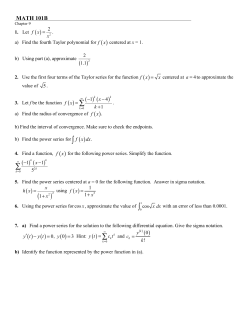
Using browsing history to identify Internet users’ interests Nikolay Anokhin data scientist
Using browsing history to identify Internet users’ interests Nikolay Anokhin data scientist Advertisement on the Web 300x300 banner ad It’s all about users (and money) 5 clothing 3 computers 5 travelling 3 gadgets 5 cars 3 photography 5 dating 3 data mining The Data: user access logs User ID A1B2C3D4 A1B2C3D4 A1B2C3D4 ... F9E8D7C6 F9E8D7C6 Timestamp 2014-07-01 13:11:37 2014-07-01 13:20:45 2014-07-02 00:25:10 URL http://auto.mail.ru/toyota http://example.com?id=football http://somesite.com/index.php Etc. M/27/... M/27/... M/27/... 2014-06-30 18:01:12 2014-06-30 18:10:51 http://my-little-pony.com/ http://afisha.mail.ry/twilight F/19/... F/19/... Text log files – about 300 G/day (and growing) Some immediate conclusions User ID A1B2C3D4 A1B2C3D4 A1B2C3D4 Timestamp 2014-07-01 13:11:37 2014-07-01 13:20:45 2014-07-02 00:25:10 URL http://auto.mail.ru/toyota http://example.com?id=football http://somesite.com/index.php ↓ A1B2C3D4: auto, toyota, football, somesite Etc. M/27/... M/27/... M/27/... Latent Dirichlet Allocation1 I Let there be M users, each user u is represented by a bag of Nu tokens I Let the number of topics (user interests) be given and equal to K Generative model I For each topic draw a topic distribution βk ∼ Dir(ηk ), k ∈ 1, . . . K II For each user u ∈ 1, . . . , M: 1 Draw the user’s topic distribution θu ∼ Dir(α) 2 For each potential token t ∈ 1, . . . , Nu : 2.1 Choose the token’s topic assignment zu,t ∼ Multl(θu ) 2.2 Choose the token wu,t ∼ Mult(βzu,t ) 1 Latent Dirichlet Allocation // Blei et. al. Generative model p(w, θ, β, z|α, η) = = p(θ|α) N Y p(zt |θ)p(wt |zt , β)p(β|η) t=1 Posterior of hidden variables p(θ, β, z|w, α, η) = p(θ, β, z, w|α, η) p(w|α, η) Variational inference q(θ, β, z) = K Y Dir(βk |λk )× k=1 × M Y Dir(θu |γu ) u=1 N Y Mult(zu,t |ϕu,t ) t=1 Maximizing the ELBO... L = Eq [log(p(w, θ, β, z)] − Eq [log q(θ, β, z)] ...is the same as minimising KL-divergence q(θ, β, z) KL(q||p) = Eq log p(θ, β, z|w) Variational EM2 E1 For each user, given α and λ, update ϕ and γ ϕt,k ∝ Eq [βt,k ] exp (Ψ(γl )) γk = αk + N X ϕt,k w =1 E2 Update λ for each topic, using the obtained ϕ λt,k = ηt,k + M X (u) (u) wt ϕt,k u=1 M Maximise lower bound of the data log likelihood w.r.t. to α using Newton-Raphson method 2 Mr. LDA: A Flexible Large Scale Topic Modeling Package using Variational Inference in MapReduce // Zhai et. al. LDA – map 1 2 3 4 5 6 7 8 9 10 11 12 13 14 15 16 17 18 19 20 function configure() load alpha, lambda and gamma from distributed cache normalize lambda for every topic function map(u, tokens) initialize a zero V x K-dimensional matrix Phi initialize a zero K-dimensional row vector sigma read user logs as tokens w[1], w[2], . . , w[N] repeat for all t in 1..V do for all k 1..K do Update Phi[t,k] = lambda[t,k]/(sum_t lambda[t,k]) * exp(Psi(gamma[u,k])) normalize phi[t,*] sigma = sigma + w[t] * phi[t,*] Update row vector gamma[u,*] = alpha + sigma until convergence for all k in 1..K do for all t in 1..V do emit <k, t> : w[t] * phi[t,k] emit <k, u> : gamma[u,k] LDA – reduce 1 2 3 4 function map(<p_left, p_right>, Sigmas) # sigma is unnormalized lambda S = sum(Sigmas) emit <p_left, p_right>: S Running LDA Typical machine config processors 2 x Intel(R) Xeon(R) 2.00GHz cores 12 threads 24 RAM 32 GB HDD 4-8 TB 30 machines in cluster Typical data: 10-days user logs Typical run time: 20 hours Modelling results – topics topic1 book books loveread knigi read author litmir labirint authors tululu topic2 klass reshebnik class megabotan resh slovo algebra yazyk reshebniki otbet topic3 mobile svyaznoy phone telefony nokia phones iphone samsung catalog allnokia topic4 avito kvartiry doma prodam dachi kottedzhi nedvizhimost sdam oblast komnaty topic5 krasnoyarsk tyumen tomsk kemerovo surgut barnaul nizhnevartovsk krsk novokuznetsk kurgan topic6 china meta shared links maincat linkwall nakanune razvezlo poster readme Conclusions and Future Work I LDA is an appropriate model for Internet user’s interests I Variational EM is an efficient algorithm for LDA parameter estimation I Variational EM is easy to parallelise using MapReduce paradigm I Profile prediction for a new user I Topics as features in data mining tasks Q&A Nikolay Anokhin n.anokhin@corp.mail.ru
© Copyright 2025





















